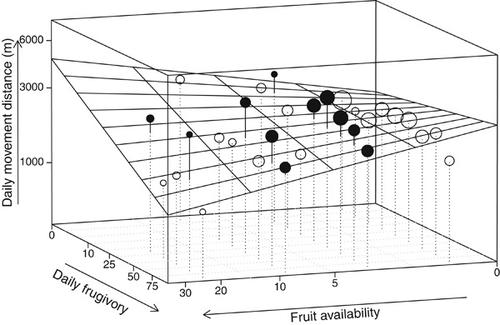当前位置:
X-MOL 学术
›
Am. J. Primatol.
›
论文详情
Our official English website, www.x-mol.net, welcomes your feedback! (Note: you will need to create a separate account there.)
Ecological correlates of space use patterns in wild western lowland gorillas.
American Journal of Primatology ( IF 2.4 ) Pub Date : 2020-06-30 , DOI: 10.1002/ajp.23168 Nicole Seiler 1 , Martha M Robbins 1
American Journal of Primatology ( IF 2.4 ) Pub Date : 2020-06-30 , DOI: 10.1002/ajp.23168 Nicole Seiler 1 , Martha M Robbins 1
Affiliation

|
The distribution of resources is a crucial determinant of animals' space use (e.g., daily travel distance, monthly home range size, and revisitation patterns). We examined how variation in ecological parameters affected variability in space use patterns of western lowland gorillas, Gorilla gorilla gorilla. They are an interesting species for investigating this topic because key components of their diet are nonfruit items (herbaceous vegetation and tree leaves) that occur at low density and are sparsely distributed, and fruits, which show high spatiotemporal variation in availability. We estimated how availability of nonfruit foods and fruit, frugivory (proportion of feeding time consuming fruit), and swamps in areas used by the gorillas influenced daily travel distance, monthly home range size, and revisit frequency to grid cells in the home range of one habituated gorilla group in Loango National Park, Gabon. Using location data from 2015 to 2018, we found that the gorillas decreased their daily travel distance as both the density of nonfruit foods and the proportion of swamps in areas used increased. Daily travel distances were shorter when both frugivory and availability of fruit were higher, yet, daily travel distances were longer when availability of fruit was low but frugivory was still high. Furthermore, monthly home range size increased as frugivory increased and monthly revisit frequencies to an area increased as fruit availability of an area increased. In conclusion, the availability of both nonfruit and fruit influenced the gorillas' space use patterns. Gorillas decreased foraging effort when food availability was high but were willing to incur increasing foraging costs to feed on fruit when availability was low. This study highlights how animals have to adjust their space use with changing resource availability and it emphasizes the value of examining multiple parameters of space use.
中文翻译:

野生西部低地大猩猩空间利用模式的生态相关性。
资源的分配是动物空间使用的关键决定因素(例如,每天的旅行距离,每月的家庭范围大小和重新游玩的方式)。我们研究了生态参数的变化如何影响西部低地大猩猩,大猩猩大猩猩大猩猩的空间利用模式的变异性。它们是研究该主题的有趣物种,因为它们饮食中的关键成分是低密度,稀疏分布的非水果类物品(草皮植被和树叶)以及水果,它们的可用性时空变化很大。我们估计了非水果食品和水果,节食(消耗时间的水果的比例)以及大猩猩使用地区的沼泽如何影响每日出行距离,每月家庭范围大小以及对一个家庭范围内网格单元的重新访问频率加蓬Loango国家公园的大猩猩种群习性。使用2015年至2018年的位置数据,我们发现大猩猩的日常出行距离随着非水果食品的密度和所使用地区的沼泽比例的增加而缩短。当节食和水果的可利用性都较高时,每日旅行距离会缩短,但是,当水果的可利用性较低但果肉仍然较高时,每日旅行距离会更长。此外,随着节食的增加,每月家庭范围的大小也增加,并且随着某个地区的水果供应量的增加,每月对该区域的重新访问频率也会增加。总之,非水果和水果的可利用性影响了大猩猩的空间利用方式。大猩猩在粮食供应量高时减少了觅食工作,但愿意在粮食供应量低时增加以水果为食的觅食成本。这项研究突出了动物如何通过改变资源的可利用性来调整其空间利用,并强调了研究空间利用的多个参数的价值。
更新日期:2020-08-26
中文翻译:

野生西部低地大猩猩空间利用模式的生态相关性。
资源的分配是动物空间使用的关键决定因素(例如,每天的旅行距离,每月的家庭范围大小和重新游玩的方式)。我们研究了生态参数的变化如何影响西部低地大猩猩,大猩猩大猩猩大猩猩的空间利用模式的变异性。它们是研究该主题的有趣物种,因为它们饮食中的关键成分是低密度,稀疏分布的非水果类物品(草皮植被和树叶)以及水果,它们的可用性时空变化很大。我们估计了非水果食品和水果,节食(消耗时间的水果的比例)以及大猩猩使用地区的沼泽如何影响每日出行距离,每月家庭范围大小以及对一个家庭范围内网格单元的重新访问频率加蓬Loango国家公园的大猩猩种群习性。使用2015年至2018年的位置数据,我们发现大猩猩的日常出行距离随着非水果食品的密度和所使用地区的沼泽比例的增加而缩短。当节食和水果的可利用性都较高时,每日旅行距离会缩短,但是,当水果的可利用性较低但果肉仍然较高时,每日旅行距离会更长。此外,随着节食的增加,每月家庭范围的大小也增加,并且随着某个地区的水果供应量的增加,每月对该区域的重新访问频率也会增加。总之,非水果和水果的可利用性影响了大猩猩的空间利用方式。大猩猩在粮食供应量高时减少了觅食工作,但愿意在粮食供应量低时增加以水果为食的觅食成本。这项研究突出了动物如何通过改变资源的可利用性来调整其空间利用,并强调了研究空间利用的多个参数的价值。


























 京公网安备 11010802027423号
京公网安备 11010802027423号